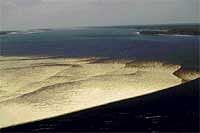Vanishing deltas

Deltas around the world are either eroding or have stopped progressing. Climate change, sea level rise, and flood management measures take the blame. Since a delta is formed where a river meets a standing body of water, there is talk about diverting more water and sediments into the bay to save the ones drowning, such as the Mississippi delta.
So far deltas were classified into three kinds depending on whether the river was the dominating force shaping it or the standing body of water: river-dominated (bird’s foot shaped), wave-dominated (fan-shaped), or tide-dominated (funnel-shaped). Geologists Douglas Edmonds and Rudy Slingerland have now proposed changing the nature of the sediments that make a delta. And the stickier the sediments, the better.
A delta composed of more cohesive sediments creates stable features that in turn retain sediment. If the sediment is non-cohesive, the delta is easily eroded. The study published online in Nature/Geoscience in December last year said that the stickiness of sediment is as important as rivers, waves and tides in controlling deltas. “This has interesting implications for the restoration of deltas, because our research suggests that the shape and morphology of the delta can be controlled on all types of coastlines. In the case of Mississippi delta, a more cohesive sediment mixture should be considered,” said Douglas Edmonds, University of Minnesota in USA and lead researcher.
Computer simulation
The authors of the study generated computer-simulated models of a rectangular standing body of water. On one of its borders, they placed a river and specified the amount of water and sediment the river carries. Thirty simulations of discharge of 1000 cubic metre per second of water carried equal concentrations of cohesive and non-cohesive sediment into the standing body of water. All other factors like waves, tides and buoyancy were kept constant.
The results showed the relative stickiness of the sediments determined whether the deltas developed into bird’s foot deltas with rough shorelines and complex floodplains (cohesive delta), such as the Mississippi River Delta, or fan-shaped deltas (non-cohesive delta) with smooth shorelines and flat floodplains such as the Nile River Delta.
Sediment inputs
The sediment stickiness is controlled in part by the amount and type of vegetation surrounding the river. The Sunderbans delta is a tide-dominated, cohesive delta. It has had no appreciable growth of new land along its coast during the last three centuries. This despite it getting a sediment load of 1.67 billion tonnes per year from the Ganga, the Brahmaputra and Meghna rivers. And it is eroding. Why?
“Delta-building is impeded by the action of destructive waves continuously eroding the land,” explained Kalyan Rudra, member of the National Flood Disaster Management core group. “Increasing sea-level rise would drown deltas if the rate of sediment deposition on the delta is less than the rate of sea-level rise,” explained Goutam Ghosh, director of Geological Survey of India in Kolkata.
How then does the theory of changing the nature of an already cohesive delta work? Edmonds stands by his study, “What my theory really says is a cohesive delta is better at retaining sediment and therefore should be less likely to drown than non-cohesive deltas. It does not mean that it will go on retaining sediments when other erosive forces are on the rise. Even adding cohesive sediment to a non-cohesive delta would not necessarily stop it from drowning. But my theory allows for the possibility that if sediment is added to the delta over time, it might be saved.”
Down to Earth Features
Waters turning hostile to estuarine life
The waters in the Sunderban delta are fast changing in quality. The western waters are fresher, lighter and less saline while the eastern sector is saltier and less transparent. Both are warmer—a sure consequence of climate change. Abhijit Mitra’s team from the department of marine science in the University of Calcutta collaborated with the school for marine science and technology in USA’s University of Massachusetts in a study that quantified the physicochemical changes in the Sunderban delta. Data was taken from the archives dating from 1980 to 2007.
The chemistry of an estuary, where river and sea waters mix, is unique; so are its flora and fauna. Any change would have a far-reaching effect. The findings of this study published in Current Science hint at the unpleasant fate of life in estuaries around a warming planet. The sea surface temperature at the Sunderban delta has been increasing at a rate of 0.5°C per decade.
Salinity decreased in the western sector but increased in the eastern Sunderbans during the last 30 years. The western rivers Hooghly and Muriganga dump waste discharges from the two biggest cities—Haldia and Kolkata—into the Western sector, but they also get replenished by glacial meltwater from the Himalayas. Hence the western sector remains fresh. The eastern end is not that lucky. Solid waste disposal and heavy siltation from the surrounding cities cut the eastern rivers off from the Himalayan water sources. The pH has decreased overall but stands higher at 8.25-8.33 than the global figure of 8.179.
Sharmila Kher, Down to Earth Features
Deccan Herald is on WhatsApp Channels| Join now for Breaking News & Editor's Picks